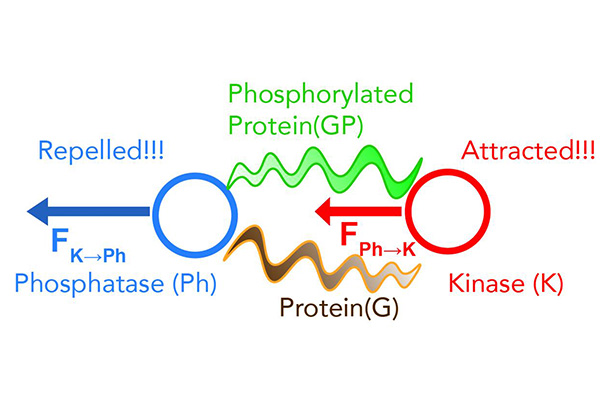
Interactions between molecules that are not equal and opposite, a seeming violation of Newton’s third law of motion, can occur naturally according to new research. A kinase enzyme adds a chemical modification to other molecules, resulting in a phosphorylated protein. Phosphatase enzymes remove the modifications, such that the kinases create products that are acted upon by phosphatases and vice versa. Researchers demonstrated that the kinase is attracted to the phosphatase, but the phosphatase is repelled by the kinase, in what is called a non-reciprocal interaction. Credit: Niladri Sekhar Mandal / Penn State. Creative Commons
Is life based on a seeming violation of Newton’s law in molecular interactions?
Interactions between molecules that are not equal and opposite can occur naturally, researchers demonstrate
March 12, 2024
Editor’s note: A version of this article originally appeared on Penn State News.
UNIVERSITY PARK, Pa. — It turns out that every action may not have an equal and opposite reaction, despite what Newton’s third law of motion says, according to new research conducted by a team from Penn State and the University of Maine. The finding could offer insight into how certain molecular interactions could have evolved in a pre-life world.
The work was published in the journal Chem, and the researchers said this is the first demonstration of the mechanism by which these interactions occur at the molecular level. Last year’s discovery by researchers at Kyoto University that sperm movement does not cause an opposite reaction in its environment as it moves provided an example of a seeming violation of Newton’s third law of motion, but it did not address the mechanism.
“We all have heard the phrase ‘every action has an equal and opposite reaction,’ to describe Newton’s third law of motion, but we see examples that seemingly violate this every day, especially in the behavior of complex living systems small and large where there is constant input of energy,” said Ayusman Sen, Verne M. Willaman Professor of Chemistry in the Eberly College of Science at Penn State and one of the research team leaders. “An example at the larger scale is that a predator is attracted to its prey, but the prey is repelled by the predator. This type of interaction is called non-reciprocal, and we were interested to see if it also occurred in the much simpler interactions among molecules with constant energy input.”
The researchers studied two enzymes — molecules that catalyze biochemical reactions — called kinases and phosphatases. Kinases add a chemical modification to other molecules. Phosphatases remove the modifications from molecules. So, the kinases create products that are acted upon by phosphatases and vice versa.
The researchers demonstrated that if the phosphatase is artificially immobilized, the kinase will be attracted to it. However, in the reverse situation where the kinase is immobilized, the phosphatase is repelled by it. One action does not have an equal and opposite reaction.
“Immobilizing one of the enzymes allows us to see how the other enzyme moves relative to the first,” said Niladri Sekhar Mandal, a graduate student in chemical engineering at Penn State and one of the paper’s authors. “The non-reciprocity that we see is not due to any external forces but results from a combination of diffusion and kinetic asymmetries, which are properties of the enzymes.”
Kinetic asymmetry describes the relative heights of energy barriers that control the direction of a reaction in relation to a concentration gradient, in this case, of the enzymes as they move in a molecular system.
“The non-reciprocal interactions allowed by kinetic asymmetry also play a crucial role in allowing molecules to interact with each other,” Sen said. “This may have played a critical role in the processes by which simple matter becomes complex, interacting in ways that eventually led to life. Because kinetic asymmetry is a property of the enzyme itself, it can undergo evolution and adaptation.”
The asymmetrical interactions between these enzymes not only help elucidate the movement of molecules within cells, but also could inform the design of synthetic molecular motors and pumps, the researchers said.
“We’re at the very beginning stages of this work, but I see understanding kinetic asymmetry as a possible opportunity for understanding how life evolved from simple molecules,” said R. Dean Astumian, a theoretical physicist at the University of Maine and one of the research team leaders. “Not only can it provide insight into complexification of matter, kinetic asymmetry can also be used in the design of molecular machines and associated technologies.”
The Air Force Office of Scientific Research funded this research.



